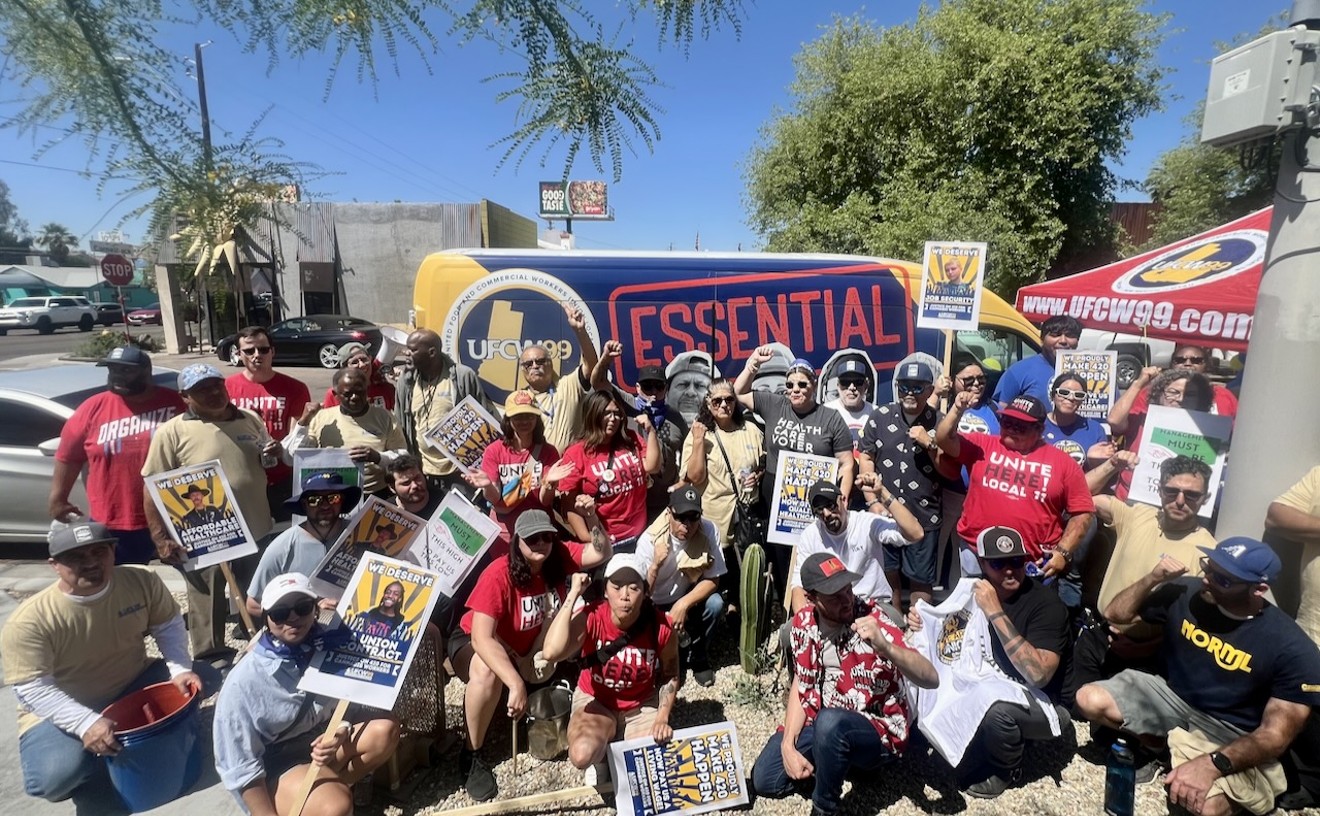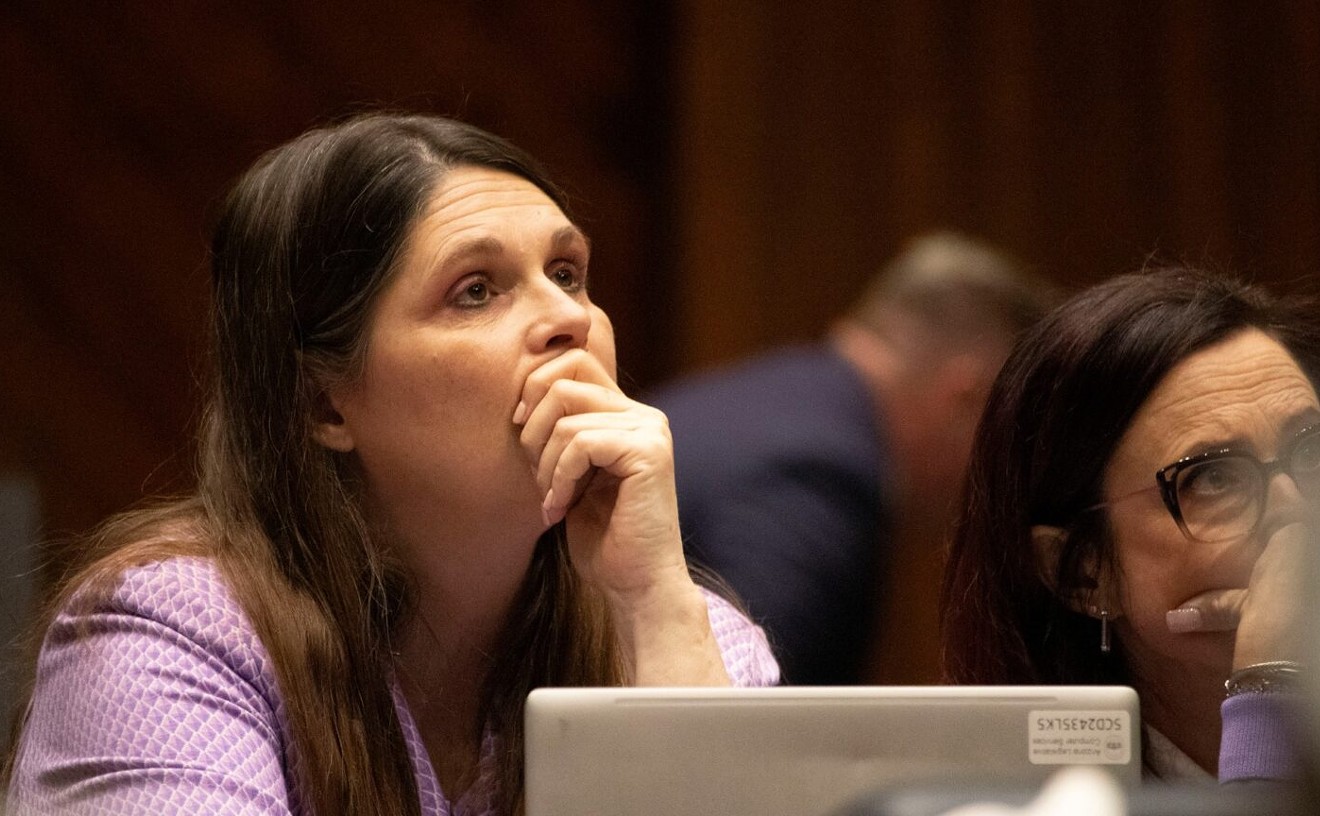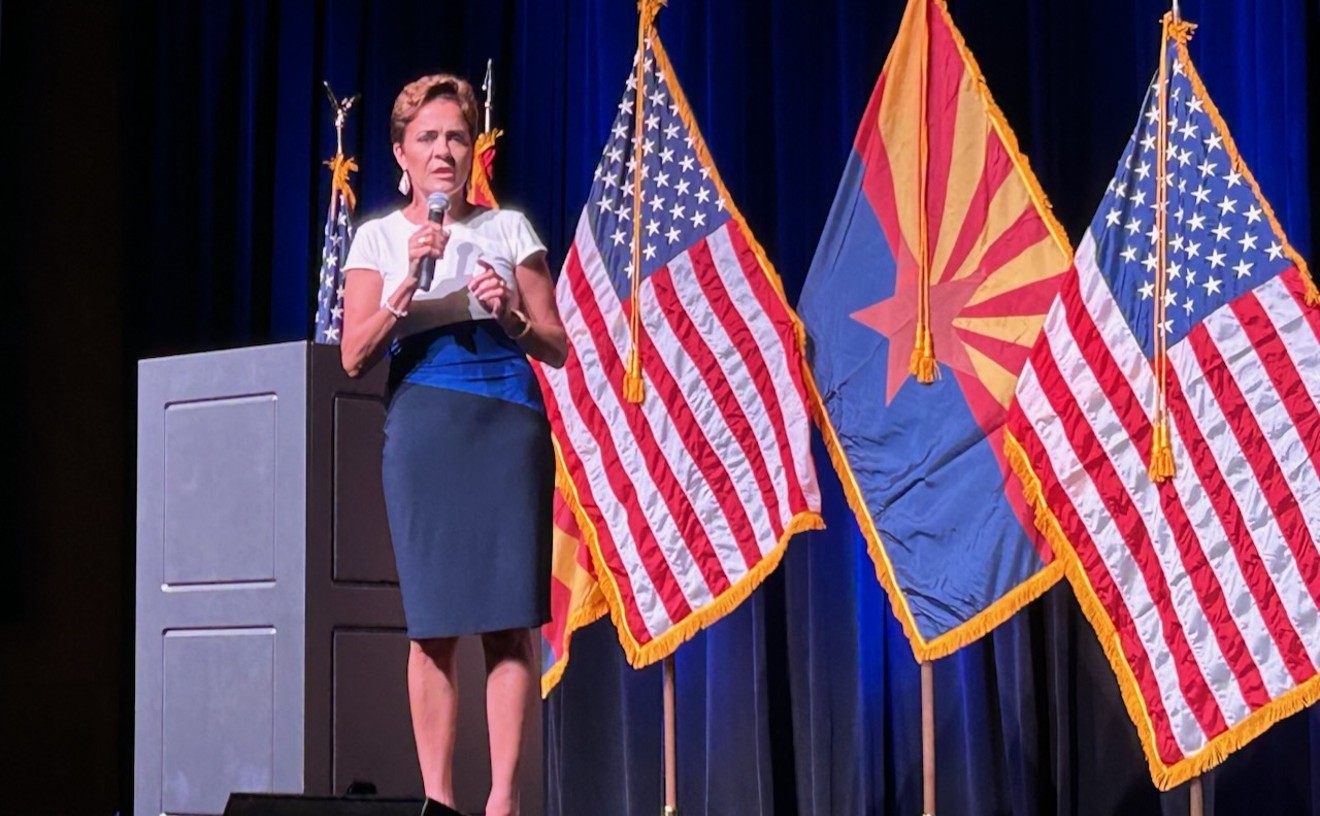Early in the morning of December 16, 2017, two weeks after Salim Richards was murdered, a dark Kia SUV carried Cleophus Cooksey Jr. along the streets around 43rd Avenue and Indian School Road in west Phoenix, back to streets he knew.
All night, the boxy hatchback had been a sanctuary. Now he needed something more permanent. Less visible.
He was a man of many monikers, but, until then, only one guise. He went by Cleo, Cook, King Playbola, Playboy, and in his own hip-hop videos, Monsta. But he always wore blue. Blue baseball cap. Blue bandanna. Blue shirt.
His hip-hop persona reflected the man he projected on the street. Gangster. Right out of the West Side City Crips, as one Phoenix detective reported a lifetime ago, as Cooksey headed to prison. He was 19 then. Now he’s 36.
Now, two hours past midnight on December 16, police were on his tail.
They didn’t know he drove the Kia. Didn’t know he had recently finished a 16-year sentence in Lewis prison on a manslaughter rap for a botched armed robbery of a strip joint.
Nor did they know, as prosecutors later alleged, that only hours earlier he’d raped a woman and shot her, and that it was his second killing of the night. Now, he was driving that woman’s Kia.
All they knew was that he was driving with his lights off and didn’t stop for police, who had their lights and sirens decidedly on.
As he approached the intersection, Cooksey took in the familiar sights: the brightly painted llanteras, the other auto shops, the fast-food joints, the QT station on the corner. And the big complex of low-rise beige stucco buildings called The Cove on 44th Apartments, on the west side of 43rd Avenue. He knew these places.
But in the dark something looked wrong. Not sanctuary.
Something in the gloom lurked in the street. The cops had laid down a spike strip, just for him, a carpet of nails to puncture the Kia’s tires and stop Cooksey in his tracks.
It proved a pivotal moment in a night and a month of violence, but that would not become known until days later. The Kia and its owner’s cellphone crisscrossed the Valley that night. Like a moth to a light, the Kia flitted through the dark near every murder scene in the alleged spree. Here is a timeline established from police records with the deaths recorded nearby in italics.

Cleophus Emmanuel Cooksey Jr., appearing on his hip-hop video "IDGAF" as King Playbola. The video was posted in November 2015, but the clothing resembles some that police link to a series of shootings between Thanksgiving and Christmas 2017.
Screen capture from YouTube
Friday, December 15, 2017, 8:30 p.m., Glendale.
Forty-three-year-old Maria Villanueva pulled her dark gray Kia Sportage into a parking stall at the Casa Bellisima apartments at 65th Avenue and Bethany Home Road. She was there for a date with her boyfriend of 10 years, Danny Retiz.
She texted Retiz to tell him she was on her way and already inside the security gate. She came over most nights after her shift at a North Valley solar panel company ended.
Their date never happened.
Cleophus Cooksey Jr. was on his cellphone in the area. He had received a text at 8:35 p.m., police later said.
Villanueva arrived three minutes later, apartment security cameras showed. She sat in her car with the dome light on, fixing her makeup.
Video surveillance cameras captured the images of a black man in dark clothing in the complex. He appeared to be lurking, avoiding contact, scoping the place.
At 8:31 p.m., a man fitting Cooksey’s description walked through the complex, stopping to size up everybody who passed him. He sat on an electrical box. When Villanueva pulled into the parking spot around 8:38 p.m., he got up and walked behind the building, out of view.
A car approached. The man in dark clothes walked back to the electrical box and watched the car leave. At 8:45 p.m., he waved his hands at the driver’s side door.
Four minutes later, the lights inside the car flashed, Villanueva got out, circled around, and entered the passenger side. The man got in on the driver’s side. At 8:52 p.m., the Kia left the apartment complex.
It remains unknown why Villanueva let the man in the car. She was never seen alive again.
Friday, December 15, 10:02 p.m., south central Phoenix.
Villanueva’s mobile phone was detected by a cell tower near Interstate 17 around 15th Avenue. At 10:14 p.m., Cooksey received a text on his phone in the area.
Sometime between 11 p.m. and midnight in south central Phoenix, gunshots pierced the night air in a neighborhood of bungalows just west of the airport.
People heard two, maybe three shots. Nobody called police.
One man later reported seeing a dark gray or brown Kia, maybe a Soul, driving in the alley just west of Third Street north toward Mohave Street. The headlights were off. The Kia turned west, and then south on the next block and flipped on the lights. It was moments after the gunfire, which most witnesses said they heard around 11:30 p.m.
This witness said he saw a black woman in her 30s driving the car. She wore big-framed glasses and her curls to her shoulders.
About half an hour later, 19 minutes after Saturday turned Sunday, Villanueva’s phone was back in Glendale, a mile and a half from where she was last seen. It was at the Urban 55 apartments on 55th Avenue, just north of Camelback Road.
Saturday, December 16, 1:50 a.m., Goodyear.
About 90 minutes later and 11 miles away, a Goodyear police officer sat in his patrol car in front of the Skechers store at the corner of Van Buren Street and Dysart Road.
A dark Kia SUV, its lights off, passed him a few feet away. He blazed his spotlight and saw surprise flash across the driver’s face.
The officer gave chase, lights flashing and sirens wailing. The Kia entered Interstate 10 heading east, back toward central Phoenix.
Villanueva’s cellphone pinged a tower near Dysart Road and Van Buren Street at 1:51 a.m.
The drive passed near the death of victim No. 4. On December 11, Jesus Real, 25, was found dead on a chaise where he had been sleeping in his Avondale apartment at 525 East Harrison Drive, a mile and a half away. He had been shot twice point-blank in the side of the face. Police have accused Real’s sisters and his girlfriend of concealing evidence in his murder. His is the only murder for which Cooksey has not been charged.
Saturday, December 16, 2:03 a.m., west Phoenix.
The Goodyear police officer cut the light-and-sound show, called for help, and followed the Kia to the 43rd Avenue exit. A few blocks away, the Kia driver evaded the officer’s attempt to pull him over.
Around that time, an Arizona Department of Public Safety cruiser joined the pursuit. During an unsuccessful attempt to stop the Kia, the highway patrol officer saw a skinny black man in his 20s with dreads, which may have been Cooksey in disguise. Two days later, after the final shooting, police discovered wigs where Cooksey lived.
The Kia now was working its way toward 43rd Avenue and Indian School Road, where DPS had laid a spike strip.
Again, the Kia somehow avoided the trap and slipped away. It was around 2:20 a.m.
The drive passed near the death of victim No. 3. On December 2, Salim Richards, 35, was shot in the chest as he was walking to his girlfriend’s apartment. She lived in The Cove on 44th Apartments, in west Phoenix, near the corner of 43rd Avenue and Indian School Road. The killer took Richards’ 9 mm Glock pistol and a golden neck chain. Cooksey was seen in an online video posted hours later wearing an identical chain.
Saturday, December 16, between 2:20 and 3:24 a.m., central Phoenix.
The Goodyear officer followed the Kia east across Indian School Road to around 19th Avenue. Then he broke off and let a Phoenix police helicopter track the car.
By then, he knew the Kia was registered to Villanueva. He called Phoenix police and asked that somebody contact her. They told him she couldn’t be reached and was at her boyfriend’s apartment.
Around 3:24 a.m., for reasons that are not known, the Phoenix helicopter stopped following the Kia around Seventh Street and Indian School Road. Maybe a higher priority call came in. Police still didn’t know the significance of the Kia or its driver. The Phoenix Police Department did not respond to a request to explain.
It’s not clear why it took an hour to get there from 19th Avenue, or if maybe, it was a typo and police meant 2:24 a.m. It was the last time police had eyes on the Kia.
At 3:15 a.m., Villanueva’s cellphone was detected nearby, on State Route 51 between Indian School and Highland Road. At 3:39 a.m., it was picked up again, at around Highland and Seventh Street.
By 4 a.m., her phone pinged the cell tower nearest the Urban 55 apartments, back in Glendale.
The drive was near the deaths of victims No. 1 and 2. The first shooting was on Nov. 27. Andrew Remillard, 27, sat in a car with his 21-year-old friend Parker Smith in a parking lot next to a Speedy Cash at the corner of 16th Street and Indian School Road.
Smith was shot at point-blank range in the forehead, the autopsy later found. Police said Remillard, the father of a young boy, was outside the car when he was also shot in the head.
The final killings, also a double homicide, were still to come, less than a mile away.
Saturday, December 16, 9:41 a.m. south central Phoenix.
A resident near Third and Mohave streets called police that morning. A man taking out the trash saw the half-naked body of Maria Villanueva. She was in the exact spot the Kia had been spotted, her back against a cinderblock wall.
She had been shot three times, one at close range in the neck. Her killer faced her, shooting her also in the cheek and in the chest.
Police found three bullet casings from a 9 mm Luger, along with a purse and a cellphone in the alley.
Later, pathologists pulled bullet fragments from her body. Lab technicians matched DNA on the woman’s genitals to Cooksey.
Maria Villanueva was victim No. 7.
Sunday, December 17, 8:20 a.m. Glendale.
A man was throwing out the trash at the Urban 55 apartments on 55th Avenue, just north of Camelback Road. As he opened the garbage bin, a cellphone rang.
He dove in, found the phone, and answered it. He spoke with a woman who didn’t know him. She was Maria Villanueva’s daughter, who then called police and reported her missing. Villanueva’s boyfriend had not called because sometimes she had to skip dates to deal with sudden family matters.
Detectives found her Kia at the complex and impounded it the next day. Inside the Kia police found evidence in troves: a cellphone registered to Cooksey and a bloody shirt. Both had Cooksey’s DNA on them, but the shirt also had the DNA of Kristopher Cameron, who had been shot dead two days earlier a quarter mile away.
The evidence mounted. The Goodyear cop later identified Cooksey in a photo lineup, even though the DPS officer could not.
The drive was near the deaths of victims Nos. 5 and 6, Lattorie Beckford and Kristopher Cameron.
On December 13, Beckford, 29, was shot dead in the Urban 55 apartments. He had two bullet holes in his head. Witnesses described Cooksey and identified him in a photo lineup. Some residents said he was known in the apartments as Playboy and might have lived there.
On December 15, Cameron, 21, was shot in a field near the Park on 57th Apartments, less than a quarter mile from the Beckford shooting. Cameron died in the hospital a day later, from wounds in the neck and abdomen. When police arrived, a man told them somebody had shot his cousin. Later when police reviewed their body-cam footage, it showed Cooksey was that man. Texts showed Cameron was meeting Cooksey to complete a drug deal, police said.

On December 17, Phoenix police responded to shots fired in the 1300 block of East Highland Avenue. That’s where Renee Cooksey, the suspect’s 56-year-old mother, and her husband, Edward Nunn, lay dead.
Phoenix PD
Sunday, December 17, 7:50 p.m., central Phoenix.
Phoenix police responded to a call of shots fired inside an apartment at 1320 East Highland Avenue.
It was mile from where the police helicopter had broken pursuit of the stolen Kia, around 40 hours earlier.
When the responding officer knocked on the blood-soaked door, Cooksey opened it. He had blood on one hand and the other tucked behind his back. He threw something from the hallway into a room and started ranting about being the strongest man alive.
Police arrested him. Then they found the bodies.
One was Rene Cooksey, Cleo’s 56-year-old mother. The other was her husband, Edward Nunn, who was 54. Cleo Cooksey lived in the apartment.
When he had been inside Lewis state prison, Cooksey removed his mother and Nunn from his visitation list, according to ADOC records that New Times obtained with a public records request.
The couple was alive the night before, as Cleo Cooksey slipped a spike strip in a stolen Kia in Glendale and a police helicopter broke off contact a mile from their home.
Now, Rene Cooksey lay dead in that apartment, alongside her husband.
They were victims Nos. 8 and 9.
What we have learned since the final two deaths.
Detectives found more evidence at Rene Cooksey’s apartment. Salim Richards’ stolen 9 mm Glock. Matching bullet casings. The key fob to Villanueva’s Kia. Cooksey’s blue bandanna and some clothes that appeared blood-soaked. And wigs.
The shootings of Villanueva and Richards are the only ones in which none of the slain had criminal records or had been implicated in drug charges.
Parker Smith had been arrested in 2016 on a minor marijuana possession charge. He accepted a diversion program and a suspended sentence. Andrew Remillard had no known criminal history.

On December 11, Avondale police responded around 3:30 p.m. to shots at an apartment complex in the 500 block of East Harrison Drive. There, they found 25-year-old Jesus Bonafacio Real dead.
Phoenix PD
Latorrie Beckford pleaded guilty in 2014 to a marijuana possession charge and took a suspended sentence. The next year, police charged him with trying to hold up a bank in Mesa without a gun. He pleaded guilty to a disorderly conduct charge and again got a suspended sentence.
Kristopher Cameron pleaded guilty in 2016 to charges of assault, resisting arrest and disorderly conduct. Police accused him of kicking officers and cussing them out when they responded to a domestic dispute. Cooksey told police he bought pot from Cameron in Avondale, which was consistent with texts between them.
Cooksey’s mother, Rene Cooksey, had no criminal record but her boyfriend, Edward Nunn, was charged in 2008 with a low-level pot crime, which was dropped after he went through a counseling program.
In 2011, Nunn was implicated in a more serious matter. Prosecutors accused him and two other men of dealing cocaine. One of the defendants, a New York man, told police he came to Phoenix every fortnight to buy two kilos of coke, according to court records. He’d buy each key for $20,000 and ship it to New York in the mail, where he sold it for double.
Nunn was caught trying to mail 1.2 pounds of coke at a Phoenix area post office. A third defendant told police he’d pay him $250 a shipment. A jury acquitted Nunn even though one witness was granted immunity from prosecution to testify.
Cleo Cooksey is back behind bars, where he spent almost half his life, awaiting trial for the case that could send him there until the end of that life.
Maricopa County Superior Court Judge Michael Kemp ordered Cooksey held without bond, after he pleaded not guilty to the murders of eight people.
He has never been charged in the murder of Jesus Real. In the most recent significant court action, his public defender tried to force prosecutors to turn over evidence from that shooting, hoping for evidence that might impeach the credibility of other parts of the investigation. Police have always maintained the ballistics were linked.
Judge Kemp denied that request last month, noting that the state says Real’s murder is still being investigated, and ruling no exculpatory evidence existed.
“We are a long way from any type of verdict,” Kemp wrote.
Cooksey’s trial is scheduled for March 2020.
READ: ANATOMY OF TWO MURDERS, PART II: SALIM RICHARDS














